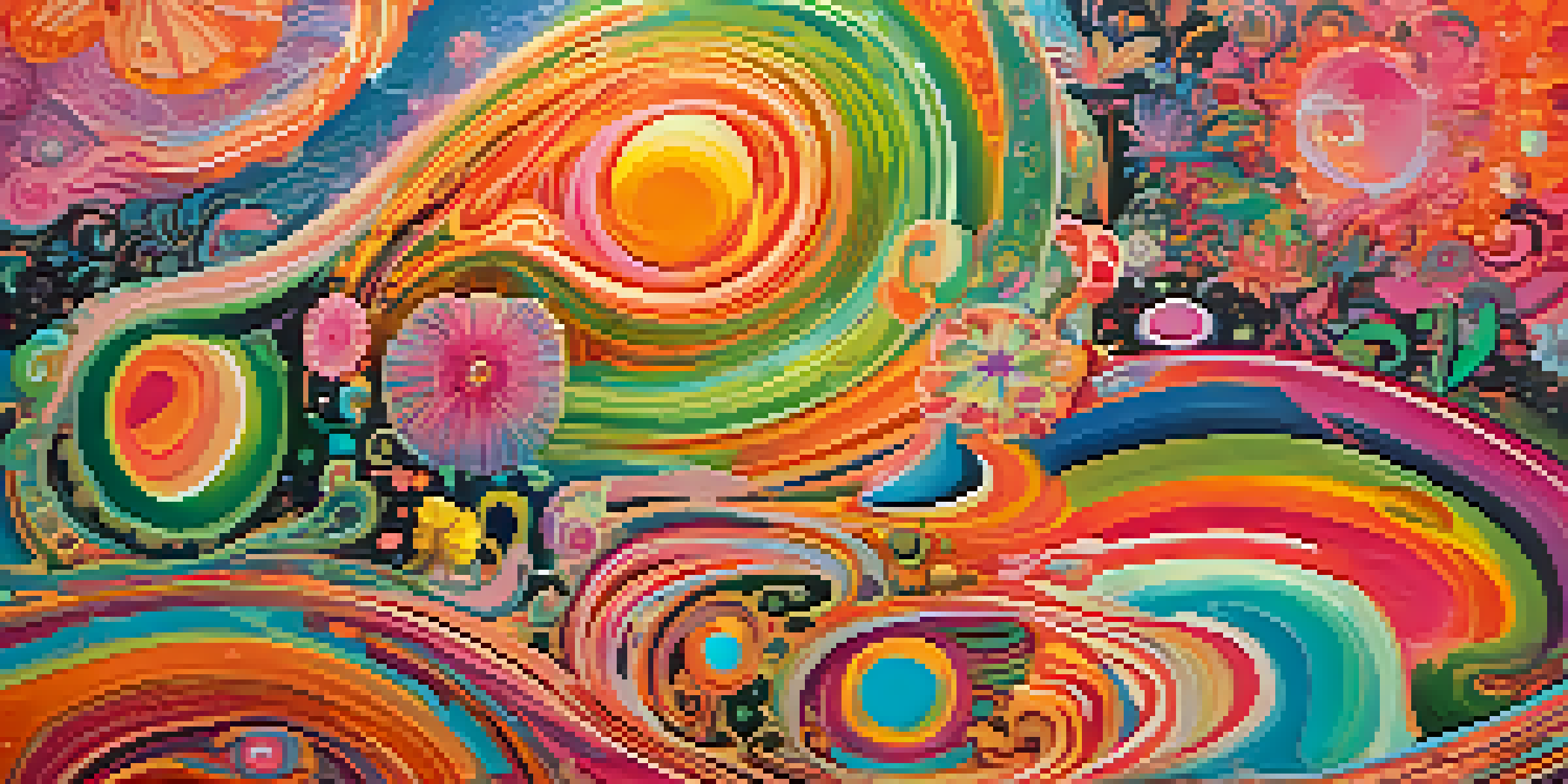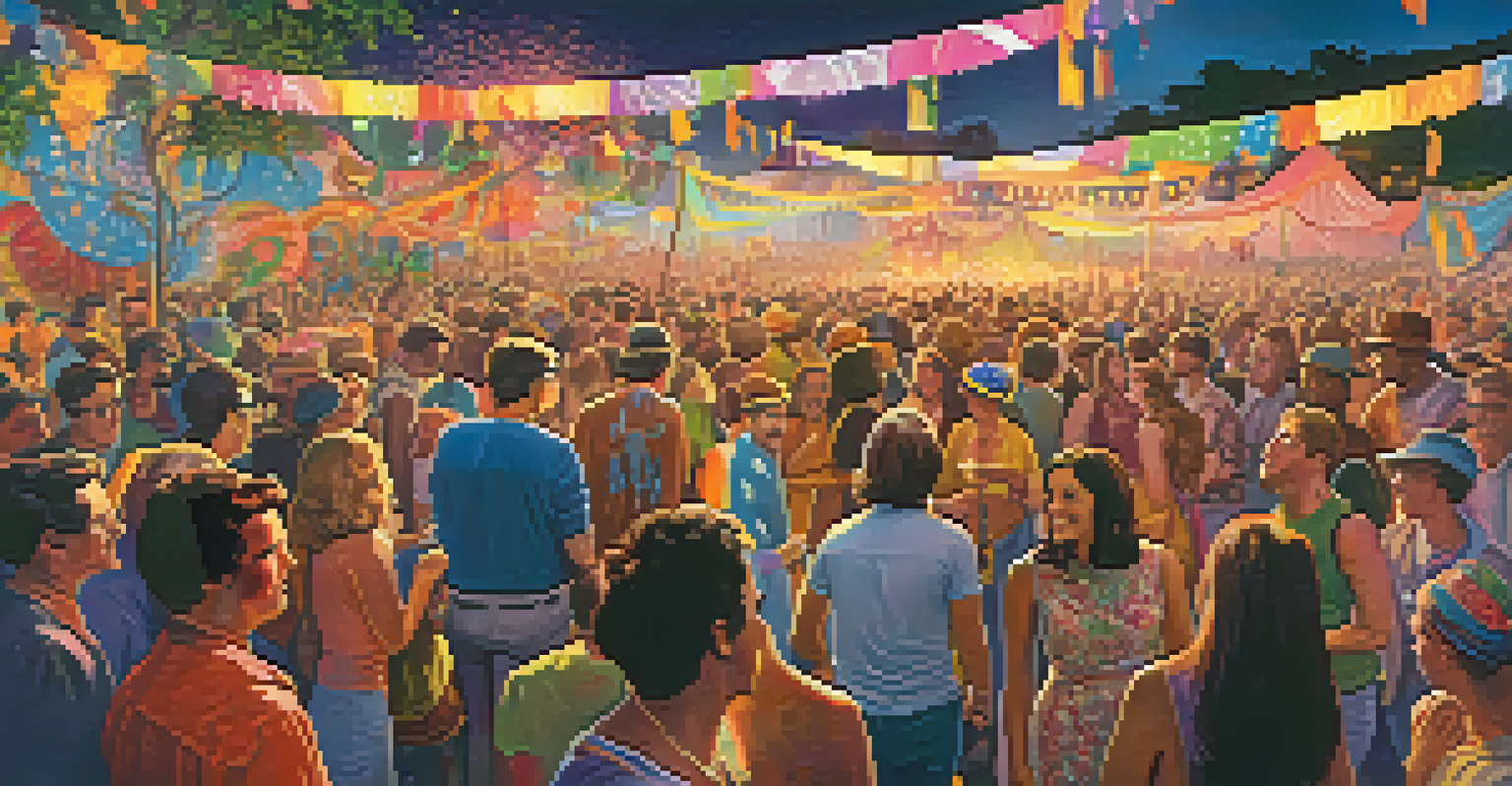The Influence of Psychedelics on 1960s Counterculture

The Birth of a Psychedelic Movement in the 1960s
The 1960s marked a significant cultural shift, fueled by the emergence of psychedelics like LSD and psilocybin. These substances promised new experiences, often described as mind-expanding, that attracted a generation seeking freedom from societal norms. With figures like Timothy Leary advocating for their use, psychedelics became synonymous with the counterculture movement.
Psychedelics can help us to access parts of ourselves that we have ignored or suppressed, and ultimately help us understand our place in the universe.
As young people experimented with these substances, they began to challenge traditional values, promoting peace, love, and self-exploration. The idea was that psychedelics could unlock deeper understanding and connection to the universe. This newfound ideology played a crucial role in shaping the cultural landscape of the decade.
The influence of psychedelics was not limited to personal experiences; it permeated all aspects of life, from art to music. The vibrant colors and surreal themes in artwork mirrored the altered states of consciousness people were experiencing, creating a unique visual language for the time.
Psychedelics and the Music Revolution
Music in the 1960s underwent a radical transformation, with psychedelics serving as a catalyst for creativity. Bands like The Beatles and The Grateful Dead began to explore new sounds and lyrical themes inspired by their experiences with these substances. Songs like 'Lucy in the Sky with Diamonds' are often interpreted as reflections of psychedelic experiences, blurring the lines between reality and imagination.

Concerts became communal experiences where attendees could fully immerse themselves in the music, often enhanced by light shows and visual art. This atmosphere fostered a sense of unity and collective consciousness, highlighting the counterculture's emphasis on togetherness and shared experiences. The music helped to solidify the movement's identity and spread its messages widely.
Psychedelics Fueled 1960s Counterculture
The emergence of psychedelics like LSD and psilocybin sparked a cultural movement that embraced self-exploration, peace, and a challenge to traditional values.
Moreover, the festival culture that emerged, epitomized by events like Woodstock, showcased the power of music as a unifying force. These gatherings celebrated freedom, love, and the exploration of consciousness, all underpinned by the psychedelic ethos that had become prevalent during the decade.
Psychedelics and the Search for Spirituality
The 1960s also saw a growing interest in spirituality, with many turning to psychedelics as tools for spiritual awakening. Influenced by Eastern philosophies, individuals sought deeper connections to themselves and the universe through altered states of consciousness. Psychedelics offered an avenue to explore these complex ideas and experiences in a tangible way.
The use of psychedelics is a doorway into a deeper understanding of ourselves and the world around us.
This quest for spirituality often led people to practices like meditation, yoga, and communal living. These practices aimed to enhance personal growth and enlightenment, creating a holistic approach to life that embraced love, peace, and mindfulness. The marriage of psychedelics with spiritual exploration was revolutionary, encouraging many to question their beliefs and pursue alternative paths.
As a result, the 1960s counterculture fostered a rich tapestry of spiritual exploration, blending ancient wisdom with modern experiences. This fusion not only transformed individual lives but also ignited a broader cultural shift towards seeking meaning beyond materialism.
Art: A Canvas for Psychedelic Expression
Art in the 1960s was profoundly influenced by the psychedelic experience, resulting in a vibrant and dynamic visual culture. Artists like Peter Max and Wes Wilson created works that captured the essence of the psychedelic experience through bold colors and intricate patterns. This artistic explosion reflected the inner journeys and collective consciousness of the counterculture.
Psychedelic art often served as a form of social commentary, addressing issues such as war, inequality, and environmentalism. The imagery created a visual dialogue that resonated with the values of the movement, pushing the boundaries of conventional art. This new form of expression not only engaged viewers but also invited them to experience the world through a different lens.
Music and Art Transformed by Psychedelics
Psychedelics inspired a revolutionary wave in music and art, leading to new sounds, vibrant visuals, and communal experiences that defined the era.
The integration of art and psychedelics extended beyond traditional mediums, influencing graphic design, fashion, and public installations. This cross-pollination of ideas fostered a creative environment that encouraged experimentation and innovation, leaving a lasting legacy on the art world.
Psychedelics in Political Activism
Psychedelics also found their place in the realm of political activism during the 1960s. Many activists believed that these substances could expand consciousness and promote empathy, making them powerful tools for social change. Groups like the Merry Pranksters embraced this idea, using psychedelics to inspire a sense of community and shared purpose in their efforts against the establishment.
The counterculture's message of peace and love resonated deeply during a time of political turmoil, particularly during the Vietnam War. Activists utilized psychedelic experiences to foster unity among diverse groups, encouraging collective action for social justice. This blending of psychedelics with activism helped to galvanize a generation committed to challenging the status quo.
As a result, the use of psychedelics became intertwined with various social movements, including civil rights and environmentalism. The belief that altered states could enhance awareness and compassion played a crucial role in shaping the political landscape of the decade, driving home the idea that personal transformation could lead to societal change.
The Role of Psychedelics in Mental Health
The conversation around psychedelics in the 1960s also touched on mental health, as researchers began to explore their therapeutic potential. Early studies suggested that substances like LSD could help treat conditions such as depression and anxiety, offering alternative avenues for healing. This sparked interest in using psychedelics as tools for personal growth and emotional well-being.
Individuals often reported profound insights and emotional breakthroughs during their psychedelic experiences, leading to increased self-awareness and personal transformation. This growing understanding of the mind's complexities prompted a shift in how mental health was viewed, encouraging a more holistic approach that considered emotional and spiritual aspects.
Psychedelics and Modern Mental Health
The therapeutic potential of psychedelics, first explored in the 1960s, is experiencing a resurgence today as society increasingly acknowledges their mental health benefits.
While the counterculture movement faced pushback and stigmatization, the seeds planted during this era have led to a resurgence of interest in psychedelic therapy today. Current research continues to explore the potential benefits of these substances, reflecting a lasting legacy of the 1960s in the ongoing dialogue about mental health and healing.
The Legacy of Psychedelics in Today's Culture
The influence of psychedelics on the 1960s counterculture is still felt today, as contemporary society grapples with the implications of their use. The resurgence of interest in psychedelics for therapeutic purposes highlights a shift in public perception, recognizing their potential benefits. This evolution can be traced back to the ideals and explorations of the previous generation.
Modern festivals and music events often draw inspiration from the psychedelic culture of the 1960s, celebrating creativity, unity, and self-expression. These gatherings serve as reminders of the power of community and the importance of connection in navigating today's fast-paced world. The spirit of love and peace continues to resonate, encouraging new generations to explore their consciousness.

As research and discourse around psychedelics evolve, the lessons learned from the 1960s remain relevant. The exploration of consciousness, empathy, and personal transformation continues to inspire individuals and movements, emphasizing the importance of understanding our shared humanity.